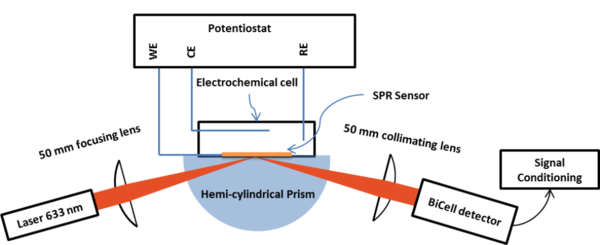Difference between revisions of "Plasmonic Detection of Bioelectrical signals"
From Applied Optics Wiki
| (34 intermediate revisions by the same user not shown) | |||
| Line 1: | Line 1: | ||
| − | This project investigates the | + | '''Project Overview''' |
| + | |||
| + | : This project investigates the capacity of surface plasmon resonance systems in voltage sensing. for measuring the fast and small-amplitude electrical activity of the electrogentic cells. Electrical signals are used by these cells to communicate with each others, creating a coherent higher level function. For instance, information processing in the nervous system is mediated by electrical signals. Similarly, the function of the cardiac muscle is controlled by the electrical excitation. Accurate and reliable measurements of these signals at the cell level provides valuable in-vitro models for physiological and pharmacological investigations. Unlike the popular fluorescent and micro-electrode techniques, surface plasmon resonance is a label-free, non-invasive way to measure localised signals at the cell-metal interface. | ||
| + | |||
| + | '''System Description''' | ||
| + | {|align="right" | ||
| + | |[[File:System diag.png|600px|Caption xxxxxx]] | ||
| + | |} | ||
| + | : Electrochemical methods are combined with a sensitive surface plasmon resonance sensing platform to measure voltage between the metal surface and the electrolyte solution of the best representation of the extracellular properties. | ||
Latest revision as of 10:10, 30 April 2016
Project Overview
- This project investigates the capacity of surface plasmon resonance systems in voltage sensing. for measuring the fast and small-amplitude electrical activity of the electrogentic cells. Electrical signals are used by these cells to communicate with each others, creating a coherent higher level function. For instance, information processing in the nervous system is mediated by electrical signals. Similarly, the function of the cardiac muscle is controlled by the electrical excitation. Accurate and reliable measurements of these signals at the cell level provides valuable in-vitro models for physiological and pharmacological investigations. Unlike the popular fluorescent and micro-electrode techniques, surface plasmon resonance is a label-free, non-invasive way to measure localised signals at the cell-metal interface.
System Description

|
- Electrochemical methods are combined with a sensitive surface plasmon resonance sensing platform to measure voltage between the metal surface and the electrolyte solution of the best representation of the extracellular properties.